Utopian and dystopian fiction are subgenres of science fiction that explore social and political structures. Utopian fiction portrays a setting that agrees with the author's ethos, having various attributes of another reality intended to appeal to readers. Dystopian fiction offers the opposite: the portrayal of a setting that completely disagrees with the author's ethos. Some novels combine both genres, often as a metaphor for the different directions humanity can take depending on its choices, ending up with one of two possible futures. Both utopias and dystopias are commonly found in science fiction and other types of speculative fiction.

Nauvoo is a town on the northwestern edge of Walker County, Alabama, United States, that extends slightly north into southwestern Winston. As of the 2010 census, the population of the town is 221, down from 284 in 2000. Camp McDowell, the official camp and conference center of the Episcopal Diocese of Alabama, is located here.

Nauvoo is a small city in Hancock County, Illinois, United States, on the Mississippi River near Fort Madison, Iowa. The population of Nauvoo was 950 at the 2020 census. Nauvoo attracts visitors for its historic importance and its religious significance to members of several groups: The Church of Jesus Christ of Latter-day Saints; the Community of Christ, formerly the Reorganized Church of Jesus Christ of Latter Day Saints (RLDS); other groups stemming from the Latter Day Saint movement; and the Icarians. The city and its immediate surrounding area are listed on the National Register of Historic Places as the Nauvoo Historic District.

Corning is a city in Quincy Township, Adams County, Iowa, United States. The population was 1,564 at the 2020 census. It is the county seat of Adams County. Corning is located just north of the intersection of U.S. Route 34 and Iowa Highway 148. Corning is perhaps best known as the birthplace of Johnny Carson. Daniel Webster Turner, who was governor of Iowa from 1931 to 1933, was born in Corning on March 17, 1877.
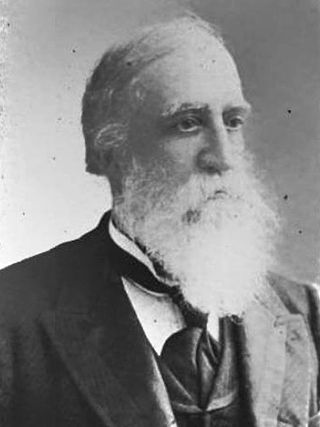
Joseph Smith III was the eldest surviving son of Joseph Smith and Emma Hale Smith. Joseph Smith III was the Prophet-President of what became the Reorganized Church of Jesus Christ of Latter Day Saints, renamed Community of Christ in 2001, which considers itself a continuation of the church established by Smith's father in 1830. For fifty-four years until his own death, Smith presided over the church. Smith's moderate ideas and nature set much of the tone for the church's development, earning him the sobriquet of "the pragmatic prophet".
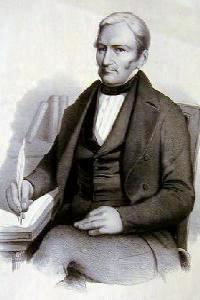
The Icarians were a French-based utopian socialist movement, established by the followers of politician, journalist, and author Étienne Cabet. In an attempt to put his economic and social theories into practice, Cabet led his followers to the United States of America in 1848, where the Icarians established a series of egalitarian communes in the states of Texas, Illinois, Iowa, Missouri, and California. The movement split several times due to factional disagreements.
Dogtown or Dog Town may refer to:

Étienne Cabet was a French philosopher and utopian socialist who founded the Icarian movement. Cabet became the most popular socialist advocate of his day, with a special appeal to artisans who were being undercut by factories. Cabet published Voyage en Icarie in French in 1839, in which he proposed replacing capitalist production with workers' cooperatives. Recurrent problems with French officials, led him to emigrate to the United States in 1848. Cabet founded utopian communities in Texas and Illinois, but was again undercut, this time by recurring feuds with his followers.
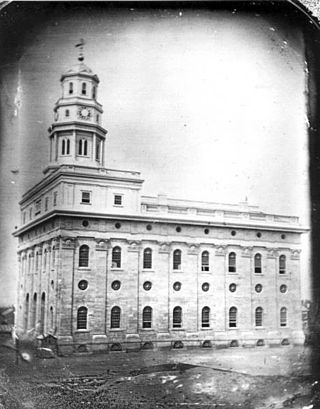
The Nauvoo Temple was the second temple constructed by the Church of Jesus Christ of Latter Day Saints. The church's first temple was completed in Kirtland, Ohio, United States, in 1836. When the main body of the church was forced out of Nauvoo, Illinois, in the winter of 1846, the church attempted to sell the building, finally succeeding in 1848. The building was damaged by fire and a tornado before being demolished.
Tom Bauer is an American lawyer and politician from St. Louis, Missouri, who served in the Missouri House of Representatives and on the St. Louis Board of Aldermen. In 2005 he was recalled from his position as alderman after supporting a controversial redevelopment proposal, using eminent domain to acquire homes to build a gas station. In March 2011, Bauer defeated incumbent 24th Ward alderman Bill Waterhouse in the Democratic primary, but lost to independent candidate Scott Ogilvie in the April general election.
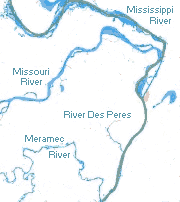
St. Louis is located at 38°38′53″N90°12′44″W.

Southampton is a neighborhood in St. Louis, Missouri. Located in the southwestern reaches of the city, its borders are Chippewa Street on the north, Hampton Avenue on the west, Eichelberger Street on the south, and South Kingshighway Boulevard on the east.
The history of Nauvoo, Illinois, starts with the Sauk and Meskwaki tribes who frequented the area, on a bend of the Mississippi River in Hancock County, some 53 miles (85 km) north of today's Quincy. They called the area "Quashquema", in honor of the Native American chief who headed a Sauk and Fox settlement numbering nearly 500 lodges. Permanent settlement by non-natives was reportedly begun in 1824 by Captain James White. By 1830, the community was called "Venus", and it was the site of the first post office in the county. In 1834 the name Venus was changed to "Commerce" in anticipation that the town would prosper under the United States' westward expansion.

Ellendale is a neighborhood of St. Louis, Missouri. Its eastern portion is considered a part of Dogtown, which also includes four other neighborhoods north of Manchester.

St. Louis Hills is a neighborhood in St. Louis, Missouri. The neighborhood, which is home to the Chippewa location of Ted Drewes Frozen Custard, is situated in the southwest part of St. Louis. It is bounded by Chippewa Street to the northwest and north, Hampton Avenue to the east, Gravois Avenue to the southeast, and the St. Louis county border to the southwest.
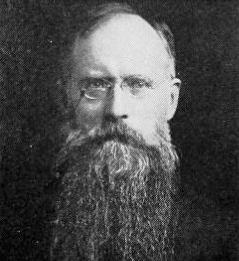
Frederick George Holweck was a German-American Catholic parish priest and scholar, hagiographer and church historian. Monsignor Holweck contributed some articles to the Catholic Encyclopedia.
John George Alleman was a missionary Catholic priest who served in the states of Ohio, Iowa and Illinois. He served as a priest in the Dominican Order from 1834 to 1840, after which time he was expelled from the order. He then served as a secular priest in the Diocese of Dubuque from 1840 to 1851, and in the Diocese of Chicago from 1851 to 1863. During his hospitalization in St. Louis, Missouri, (1863–1865) he was accepted back into the Dominican Order.

Clayton–Tamm is a historic St Louis neighborhood and once an Irish-American enclave located near the western border of St. Louis, Missouri, USA, just south of Forest Park.
Fields Foods is a grocery store chain operating in the St. Louis, Missouri area.
















